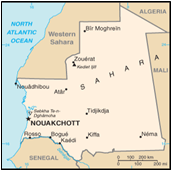- What We Do
- Agriculture and Food Security
- Democracy, Human Rights and Governance
- Economic Growth and Trade
- Education
- Ending Extreme Poverty
- Environment and Global Climate Change
- Gender Equality and Women's Empowerment
- Global Health
- Water and Sanitation
- Working in Crises and Conflict
- U.S. Global Development Lab
April 24, 2017
Food Security Situation

- Mauritania continues to struggle with chronic poverty, ranking 157 of 188 countries on the UN Development Program’s 2016 Human Development Index.
-
Mauritania is structurally food deficient, importing approximately 70 percent of its food each year. Populations in the country’s eastern and southern regions depend upon subsistence agriculture and pastoralism as their primary livelihoods, and are especially vulnerable in the case of decreased rainfall. Chronic food insecurity affects approximately 15 percent of the population.
-
The presence of over 49,000 Malian refugees in one of the most vulnerable areas of Mauritania continues to result in emergency needs and strain local populations’ food stocks and resources.
- The Famine Early Warning Systems Network (FEWS NET) expects most of Mauritania to remain in Minimal (IPC Phase 1)* acute food insecurity through September 2017. However, communities in the west of the agropastoral zone—south Aleg, Magta Lahjar, Moudjeria, Monguel, M’Bout, and west of Kankossa—are experiencing Stressed (IPC Phase 2) acute food insecurity due to low agricultural production and seasonal incomes, negatively impacting livestock sales and challenging vulnerable households to maintain the quality of their livestock.
Food Assistance Programs
-
The Office of Food for Peace (FFP) provides food assistance to vulnerable Mauritanians and Malian refugees.
-
FFP is supporting activities to strengthen Mauritania’s food security and resilience to future shocks. This includes partnering with non-governmental organizations to provide food vouchers and cash-for-work (CFW) opportunities, supporting both household food consumption and local economies. Through CFW, FFP is improving productive community infrastructure to increase community access to water, diversify livelihoods, and ensure food security even during drought years.
-
FFP partners with the UN World Food Program (WFP) to provide in-kind emergency food assistance to Malian refugees residing in Mauritania. Through the UN Children’s Fund (UNICEF), FFP is providing ready-to-use therapeutic food to children suffering from severe acute malnutrition (SAM). FFP also supports UNICEF to strengthen communities’ ability to detect and refer SAM cases early, and to reinforce national nutrition monitoring and data collection.
Food for Peace Contributions
Total Contributions:
| U.S. Dollars | Metric Tons | |
|---|---|---|
| Fiscal Year 2017 | $3.0 million | 2,010 MT |
| Fiscal Year 2016 | $5.9 million | 2,220 MT |
| Fiscal Year 2015 | $11.6 million | 5,030 MT |
| Fiscal Year 2014 | $10.2 million | 3,640 MT |
| Fiscal Year 2013 | $6.5 million | 4,550 MT |
Fiscal Year 2017 Contribution Breakdown:
| U.S. Dollars | Metric Tons | |
|---|---|---|
| Title II Development | ---- | ---- |
| Title II Emergency | $3.0 million | 2,010 MT |
| Emergency Food Security Program (EFSP) | ---- | ---- |
*The Integrated Food Security Phase Classification (IPC) is a standardized tool that aims to classify the severity and magnitude of food insecurity. The IPC scale, which is comparable across countries, ranges from Minimal—IPC I—to Famine—IPC 5.
Food Security Situation information is provided by WFP, UNHCR, FEWS NET, and UNDP.
FY 2017 contribution based on funds obligated to date.







Comment
Make a general inquiry or suggest an improvement.